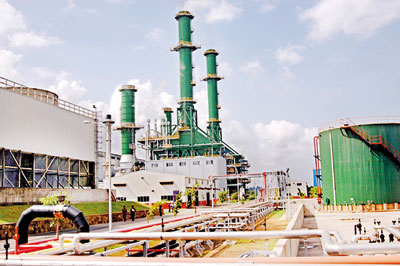News
Expert committee slams CEB for last year’s islandwide blackout
An expert committee has slammed the Ceylon Electricity Board (CEB) over last year’s countrywide power failure.
It was triggered by an electrical superintendent bypassing standard maintenance procedure at the Kerawalapitiya grid substation and went for over six hours owing to hydropower generators repeatedly tripping during restoration attempts.
The interruption, which started around 12.30pm on August 17 last year, involved all of the country’s transmission lines, power stations and grid substations. Every electricity consumer was disconnected from supply. The Power Ministry Secretary appointed a nine-member committee to investigate and its report–along with dissenting views from two members–was released this week.

The power failure was triggered by an electrical superintendent bypassing standard maintenance procedure at the Kerawalapitiya grid substation
The electrical superintendent’s actions during routine maintenance at Kerawalapitiya caused a “three phase to ground fault”, the most severe in a power system. It took the Yugadhanavi combined cycle power plant out and then tripped all three units of the Lakvijaya coal power plant, all within milliseconds.
With 810 megawatts of power lost, system frequency started to drop. This caused all other generators in the country to also trip due to under-frequency and the total system collapsed in cascade, the report observes.
The mishap at Kerawalapitiya pointed to the absence of a “robustly-framed standard operating practice on critical and high risk operations”, says the committee, which was chaired by K H D K Samarakoon, State Secretary, Ministry of Power.
The electrical superintendent carried out his assignment at the Kerawalapitiya grid substation without supervision by superiors or instructions from relevant engineers. During the five years that he has performed routine maintenance, he worked by himself with his team around, without senior oversight.
This showed a reliance on the experience of personnel carrying out maintenance rather than a robust maintenance protocol that adopted best maintenance practices related to high risk maintenance work, the report said.
“It cannot be attributed to a simple human error,” it held. “It is a complete negligence of all parties responsible for the maintenance work.”
At Lakvijaya, Unit 3 tripped first, followed by Unit 2 and Unit 1. The reason was that the “variation of frequency with time” exceeded the threshold limit of 2 megahertz per second (Hz/s) in response to the fault at Kerawalapitiya.
However, the three units were on “house load” for about one hour, two-hours-and-twenty minutes and 12 minutes, respectively. This is an “idle” mode in which a plant is not connected to the grid but its generator produces sufficient electricity to keep its own equipment (such as pumps, blowers, etc) running. In such a state, it can either be sent into controlled shutdown or restarted faster.
If grid power is restored in time, electricity generation could be resumed without interruption. In this instant, two of Lakvijaya’s three units were on house load for more than the recommended 30 minutes. Without grid power, however, they went into uncontrolled shutdown. And it was several days before they were back online.
Despite a previous expert committee having recommended it as far back as February 2017, there still is no auxiliary (external) power supply mechanism at Lakvijaya to keep the units alive in the event of a grid failure, the report points out. Having one can facilitate a controlled shutdown of plants so they can be restarted without waiting for three to four days.
The committee examined in detail why it took six-hours-and-16-minutes to restore electricity. They obtained two reports from the CEB’s System Control Centre (SCC), closed circuit television records, duty roster, attendance sheet, etc.
They found that the SCC had started restoration in the Mahaweli complex, Laxapana complex and Samanalawewa complex simultaneously. It took three hours and seven minutes for part of the power network to come live. And it was only at 6.46pm that the Mahaweli complex was stabilized and synchronized, restoring power countrywide.
There were seven restoration attempts, the final of which was successful. In the case of the other six, generators at some hydropower stations kept tripping. The committee observes that the SCC had not followed the system restoration procedure stipulated in the system restoration manual that could have ensured the fastest restoration of the transmission network.
“Surprisingly, the SCC has used the Mahaweli complex to restore the Colombo city power via Biyagama GSS [grid substation] which is a place where heavy industrial loads are connected,” the report states. “Unless in case of failure of critical GSS and transmission lines in the system restoration path from New Laxapana the restoration manual has nowhere indicated to use the Mahaweli complex to restore power to Colombo city.”
Meanwhile, CCTV records have shown the two engineers on duty at the time of the fault browsing the internet on laptops. One seemed to be on Facebook, the report said: “Even though they can’t avoid a blackout of this nature, there can be some alarms/signals which could be attended and prevent any possible failures in the system if they keep eye on the system.”
“The CEB’s recent failure to avoid a countrywide blackout and the longer duration taken to restore power to Colombo city, in particular, indicates significant lapses in implementation of critical measures outlined in the previous expert committee reports,” the committee concludes.


